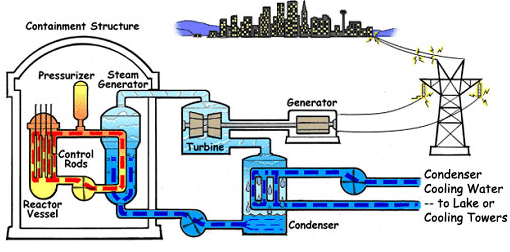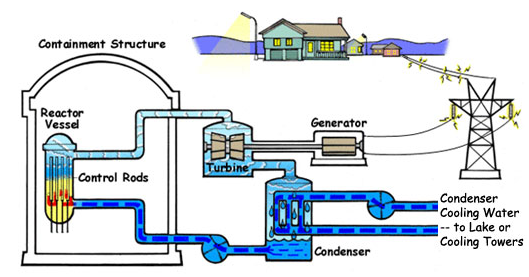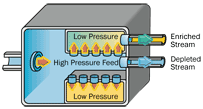Reference no: EM13693915
Part 1
The radiation hazards to human beings arise from
• exposure of the body to external radiation
• ingestion or inhalation of radioactive matter
The effect of radiation depends on the nature of the radiation and the dose received.
• Alpha: The hazard from alpha particles is slight (unless the source enters the body) since they cannot penetrate the outer layers of the skin. (If the source enters the body, it can be fatal as well.
• Beta: Beta particles are in general more penetrating than alpha particles. Most of their energy is absorbed by surface tissues and a few milimetres of aluminium is sufficient to provide adequate protection.
• Gamma: Gamma rays are highly penetrating. They can penetrate deeply into the body and may require a few centimetres of lead or concrete shielding.
Radiation can cause immediate severe damage to body tissue such as radiation burns. Delayed effects such as cancer and eye cataracts may appear many years later. Hereditary defects may occurs in succeeding generations due to genetic damage.
When radiation passes through living tissues, it can damage the structure of molecules leading to the malfunction or death of living cells. Some cells can recover, others cannot and the effects on tissues are cumulative.
Chromosomes are particularly sensitive to ionising radiation at the moment of cell division resulting in genetic mutations which are probably harmful. Such genetic mutations can lead to birth defects if an unborn child and/or the mother is exposed to radiation.
Part 2
How Do Nuclear Plants Work?
In a nuclear-fueled power plant - much like a fossil-fueled power plant - water is turned into steam, which in turn drives turbine generators to produce electricity. The difference is the source of heat. At nuclear power plants, the heat to make the steam is created when uranium atoms split - called fission. There is no combustion in a nuclear reactor. Here's how the process works.
There are two types of nuclear reactors in the United States:
Pressurized Water Reactor
Pressurized Water Reactors (also known as PWRs) keep water under pressure so that it heats, but does not boil. This heated water is circulated through tubes in steam generators, allowing the water in the steam generators to turn to steam, which then turns the turbine generator. Water from the reactor and the water that is turned into steam are in separate systems and do not mix.
View image of a Pressurized Water Reactor

A detailed description of the process:
1. The Fuel
The fuel used in nuclear generation is primarily uranium 235. It is manufactured as small round fuel pellets. A single pellet is less than an inch long, but produces the energy equivalent to a ton of coal. The pellets are placed end-to-end into fuel rods that are 12 feet long. Over 200 of these rods are grouped into what is known as a fuel assembly.
2. Reactor
The process of producing electricity begins when uranium atoms are split (i.e., fission) by particles known as neutrons. Uranium 235 has a unique quality that causes it to break apart when it collides with a neutron. Once an atom of uranium 235 is split, neutrons from the uranium atom are free to collide with other uranium 235 atoms. A chain reaction begins, producing heat. This reaction is controlled in several ways, including by control rods which absorb neutrons.
Control rods are inserted among the fuel assembly rods that hold the uranium pellets. When they are in place, they absorb the atomic particles that would normally initiate the chain reaction. When they are withdrawn from the fuel assembly, fission is allowed to occur.
3. Pressurizer
The heat produced in the reactor is transferred to the first of three water systems: the primary coolant. The primary coolant is heated to over 600 degrees Fahrenheit. In a pressurized water reactor, a pressurizer keeps the water under pressure to prevent it from boiling.
4. Steam Generator
The hot, pressurized water passes through thousands of tubes in nearby steam generators. These tubes are surrounded by another water system called the secondary coolant. The heat from the primary coolant is transferred to the secondary coolant, which then turns into steam.
The primary and secondary systems are closed systems. This means that the water flowing through the reactor remains separate and does not mix with the water from the other system or the lake.
5. Turbine
The steam is piped from the containment building into the turbine building to push the giant blades of a turbine. The turbine is connected to an electric generator by a rotating shaft. As the turbine blades begin to spin, a magnet inside the generator also turns to produce electricity.
6. Condenser Coolant
After turning the turbines, the steam is cooled by passing it over tubes carrying a third water system, called the condenser coolant or lake water. The steam is cooled so it condenses back into water and is returned to the steam generator to be used again and again.
7. Lake or Cooling Towers
At some nuclear stations, lake water flows through thousands of condenser tubes to condense steam back to water. It is then discharged down a long canal (for cooling) and eventually enters the main part of the lake.
At other plants, the condenser cooling water is circulated through cooling towers to remove the extra heat it has gained. The water is pumped to the top of the cooling towers and is allowed to pour down through the structure. At the same time, a set of fans at the top of each tower pulls air up through the condenser water. This lowers the temperature of the water. After it is cooled, the condenser water flows back into the turbine building to begin its work of condensing steam again.
Boiling Water Reactor
In Boiling Water Reactors (also known as BWRs), the water heated by fission actually boils and turns into steam to turn the turbine generator. In both PWRs and BWRs, the steam is turned back into water

Part 3
Enriching Uranium:
Enriching uranium increases the proportion of uranium atoms that can be "split" by fission to release energy (usually in the form of heat) that can be used to produce electricity. Not all uranium atoms are the same. When uranium is mined, it consists of about 99.3% uranium-238 or U-238 (U238), 0.7% uranium-235 or U-235 (U235), and < 0.01% uranium-234 or U-234 (U234). These are the different isotopes of uranium, which means that while they all contain 92 protons in the atom's center, or nucleus (which is what makes it uranium), the U238 atoms contain 146 neutrons, the U235 atoms contain 143 neutrons, and the U234 atoms contain only 142 neutrons. (The total number of protons plus neutrons gives the atomic mass of each isotope - that is, 238, 235, or 234, respectively.)
The fuel for nuclear reactors has to have a higher concentration of U235 than exists in natural uranium ore. This is because U235 is "fissionable," meaning that it starts a nuclear reaction and keeps it going. Normally, the amount of the U235 isotope is enriched from 0.7% of the uranium mass to about 5%, as illustrated in this diagram of the enrichment process.
Gaseous diffusion is the only process currently being used in the United States to commercially enrich uranium. Gas centrifuges and laser separation can also be used to enrich uranium, as described below.
Gaseous Diffusion:
Process: In the gaseous diffusion enrichment plant, uranium hexafluoride (UF6) gas is slowly fed into the plant's pipelines where it is pumped through special filters called barriers or porous membranes. The holes in the barriers are so small that there is barely enough room for the UF6 gas molecules to pass through. The isotope enrichment occurs when the lighter UF6 gas molecules (with the U234 and U235 atoms) tend to diffuse faster through the barriers than the heavier UF6 gas molecules containing U238. One barrier isn't enough, though. It takes many hundreds of barriers, one after the other, before the UF6 gas contains enough U235 to be used in reactors. At the end of the process, the enriched UF6 gas is withdrawn from the pipelines and condensed back into a liquid that is poured into containers. The UF6 is then allowed to cool and solidify before it is transported to fuel fabrication facilities where it is turned into fuel assemblies for nuclear power plants. The diagram to the right illustrates this gaseous diffusion enrichment process.
Hazards: The primary hazard in gaseous diffusion plants include the chemical and radiological hazard of a UF6 release and the potential for mishandling the enriched uranium, which could create a criticality accident (inadvertent nuclear chain reaction).
Plants: The only gaseous diffusion plant in operation in the United States is in Paducah, Kentucky. A similar plant is located near in Piketon, Ohio, but it was shut down in March 2001. Both plants are leased to the United States Enrichment Corporation (USEC) from the U.S. Department of Energy and have been regulated by the NRC since March 4, 1997.

Gas Centrifuge
The gas centrifuge uranium enrichment process uses a large number of rotating cylinders in series and parallel formations. Centrifuge machines are interconnected to form trains and cascades. In this process, UF6 gas is placed in a cylinder and rotated at a high speed. This rotation creates a strong centrifugal force so that the heavier gas molecules (containing U238) move toward the outside of the cylinder and the lighter gas molecules (containing U235) collect closer to the center. The stream that is slightly enriched in U235 is withdrawn and fed into the next higher stage, while the slightly depleted stream is recycled back into the next lower stage. Significantly more U235 enrichment can be obtained from a single-unit gas centrifuge than from a single-unit gaseous diffusion stage. The diagram to the right illustrates this gas centrifuge enrichment process.
One gas centrifuge commercial production plant, the URENCO USA facility owned by Louisiana Energy Services (LES), is currently operating in Eunice, NM. A license was issued to AREVA Enrichment Services, LLC in October 2011 to construct and operate the Eagle Rock Enrichment Facility, a gas centrifuge commercial facility, in Bonneville County, ID. The construction of the facility is currently on hold. USEC Inc., in Piketown, OH, was issued a license in April 2007 to construct and operate the American Centrifuge Plant (ACP). Construction of the ACP began in 2007 but was placed on hold in 2009. In addition, USEC Inc. was granted a license in February 2004 for a demonstration and test gas centrifuge plant, the Lead Cascade facility, that is in operation.

Laser Separation
Isotopic separation of uranium can be achieved based on photoexcitation principles (exciting the molecules using laser light). Such technologies have been named Atomic Vapor Laser Isotope Separation (AVLIS), Molecular Laser Isotope Separation (MLIS), and Separation of Isotopes by Laser Excitation (SILEX). In general, the enrichment process entails using three major systems, which are the laser systems, optical systems, and separation module system. Tunable lasers can be developed to deliver a highly monochromatic radiation (light of a single-color). The radiation from these lasers can photoionize a specific isotopic species while not affecting other isotopic species. The affected species is then physically or chemically changed, which enables the material to be separated. AVLIS used a uranium-iron (U-Fe) metal alloy as its feed material, while SILEX and MLIS use UF6 as its feed material.
No laser separation uranium enrichment plants are currently operating in the United States. However, in July 2007, General Electric - Hitachi submitted a license amendment request to the NRC, seeking approval for research and development associated with laser enrichment to be conducted at its Global Nuclear Fuels-Americas, LLC, facility in Wilmington, NC. The NRC approved the amendment on May 12, 2008, and GE-Hitachi is currently constructing the test loop with the intention of beginning operations in the near future. In addition, in June 2009, GE-Hitachi submitted a license application to construct a commercial laser enrichment plant in Wilmington, NC. The NRC staff is currently reviewing that application.
Part 4
Types of Nuclear Reactors
Nuclear reactors serve three general purposes. Civilian reactors are used to generate energy for electricity and sometimes also steam for district heating; military reactors create materials that can be used in nuclear weapons; and research reactors are used to develop weapons or energy production technology, for training purposes, for nuclear physics experimentation, and for producing radio-isotopes for medicine and research. The chemical composition of the fuel, the type of coolant, and other details important to reactor operation depend on reactor design. Most designs have some flexibility as to the type of fuel that can be used. Some reactors are dual-purpose in that they are used for civilian power and military materials production. The two tables below give information about civilian and military reactors.
|
Types of Nuclear Reactors - Table 1
|
|
|
Reactor Type
|
Light Water Reactor (LWR)
|
Heavy Water Reactor (HWR)
|
|
|
a. Boiling Water Reactor
|
b. Pressurized Water Reactor (PWR)
|
|
|
Purpose
|
electricity
|
electricity; nuclear powered ships (U.S.)
|
electricity; plutonium production
|
|
|
Coolant Type
|
water (H2O)
|
water
|
heavy water (deuterium oxide, D2O)
|
|
|
Moderator Type
|
water
|
water
|
heavy water
|
|
|
Fuel - Chemical Composition
|
uranium-dioxide (UO2)
|
uranium-dioxide
|
uranium-dioxide or metal
|
|
|
Fuel - Enrichment Level
|
low-enriched
|
low-enriched
|
natural uranium (not enriched)
|
|
|
Comments
|
steam generated inside the reactor goes directly to the turbine
|
steam is generated outside the reactor in a secondary heat transfer loop
|
used in Canada: called "CANDU" - "Canadian Deuterium Uranium;" Also used in Savannah River Site reactors (metal fuel at SRS)
|
|
|
Types of Nuclear Reactors - Table 2
|
|
|
Reactor Type
|
Graphite Moderated Reactor
|
Fast Breeder Reactor (FBR)
|
|
|
a. Gas Cooled
|
b. Water Cooled
|
Liquid Metal (LMFBR) (most common type of breeder)
|
|
|
Purpose
|
electricity; plutonium production
|
electricity; plutonium production
|
electricity; plutonium production
|
|
|
Coolant Type
|
gas (carbon dioxide or helium)
|
water
|
molten, liquid sodium
|
|
|
Moderator Type
|
graphite
|
graphite
|
not required
|
|
|
Fuel - Chemical Composition
|
uranium dicarbide (UC2) or uranium metal
|
uranium dioxide (RBMK) or metal (N-reactor)
|
plutonium dioxide and uranium dioxide in various arrangements
|
|
|
Fuel - Enrichment Level
|
slightly-enriched, natural uranium
|
slightly-enriched
|
various mixtures of plutonium-239 and uranium-235
|
|
|
Comments
|
used in Britain, and France (e.g.: AGR, MAGNOX)
|
used in former Soviet Union, e.g. Chernobyl (RBMK); N-reactor at Hanford.
|
breeder reactors are designed to produce more fissile material than they consume. Monju; Phenix
|
|
Part 5
End the nuclear age
We need an energy system that can fight climate change, based on renewable energy and energy efficiency. Nuclear power already delivers less energy globally than renewable energy, and the share will continue to decrease in the coming years.
Despite what the nuclear industry tells us, building enough nuclear power stations to make a meaningful reduction in greenhouse gas emissions would cost trillions of dollars, create tens of thousands of tons of lethal high-level radioactive waste, contribute to further proliferation of nuclear weapons materials, and result in a Chernobyl-scale accident once every decade. Perhaps most significantly, it will squander the resources necessary to implement meaningful climate change solutions. (Briefing: Climate change - Nuclear not the answer.)
The Nuclear Age began in July 1945 when the US tested their first nuclear bomb near Alamogordo, New Mexico. A few years later, in 1953, President Eisenhower launched his "Atoms for Peace" Programme at the UN amid a wave of unbridled atomic optimism.
But as we know there is nothing "peaceful" about all things nuclear. More than half a century after Eisenhower's speech the planet is left with the legacy of nuclear waste. This legacy is beginning to be recognised for what it truly is.
Things are moving slowly in the right direction. In November 2000 the world recognised nuclear power as a dirty, dangerous and unnecessary technology by refusing to give it greenhouse gas credits during the UN Climate Change talks in The Hague. Nuclear power was dealt a further blow when a UN Sustainable Development Conference refused to label nuclear a sustainable technology in April 2001.
The risks from nuclear energy are real, inherent and long-lasting.